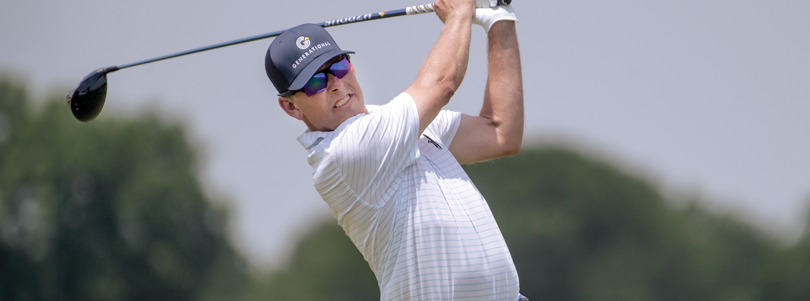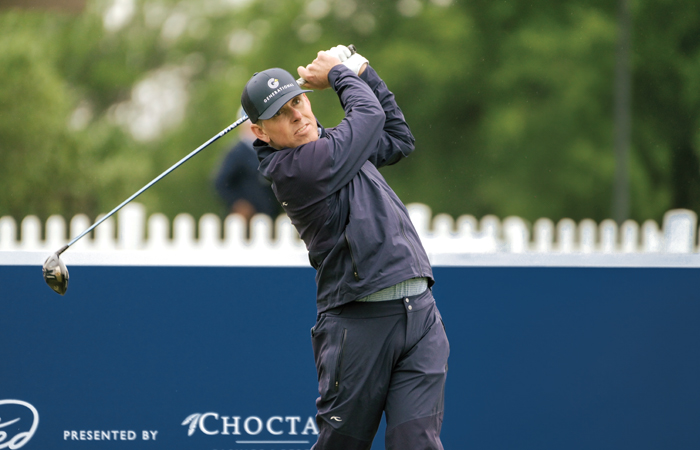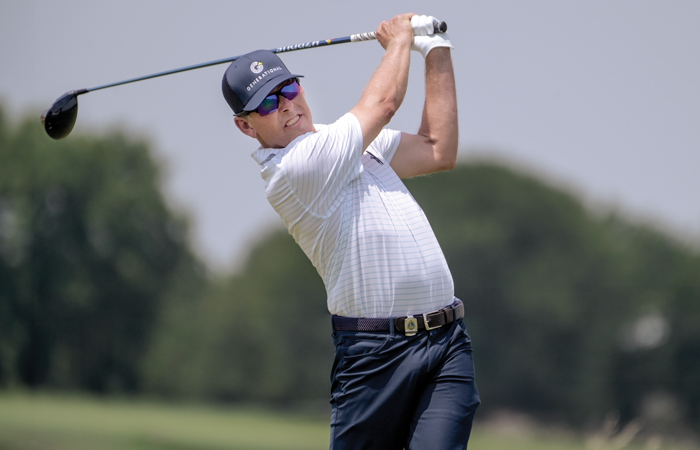Feature Story – Leonard’s Links

Dallas native Justin Leonard has won at every level of golf, except one. As he embarks on his second full PGA TOUR Champions season, he is still looking for his first victory on the 50-and-over tour.
He played 19 events in 2023 and had 12 top-25 finishes and five top-10 finishes, including a playoff loss in the Pure Insurance Championship in September. The $872,298 he earned was his best season since making $952,962 on the PGA TOUR in 2011.
Leonard, who has one top-10 finish in his first three events this year, has committed to play in the Invited Celebrity Classic at Las Colinas Country Club on April 19-21. He finished 10th in his debut last year.

At Lake Highlands High School, Leonard was on the 1988 Class 5A state championship team and won individual titles in 1989 and ‘90. He won the U.S. Amateur in 1992 and the NCAA individual title playing for Texas in 1994 at Stonebridge Country Club in McKinney.
Leonard, who earned his PGA TOUR card without having to play on a mini-tour or go through qualifying school, won 12 times on the PGA TOUR and earned more than $33 million. He won The Players Championship in 1998 and the British Open the following year.
We caught up with Leonard at January’s PGA Merchandise Show, where he was promoting Golf Forever, a golf fitness training product that he has been involved with since its inception. The questions and answers were lightly edited for clarity and space.
Q: Where is home for you now?
Justin Leonard: I live in Tequesta, Fla., just north of Jupiter, like 30 minutes north of West Palm Beach.
We moved there in June of 2022. We moved from Colorado to Florida.
Q: I always thought of you as a lifetime Dallas guy. Why did you move?
JL: We moved in 2015 to Colorado. We just kind of wanted to live a different life. We wanted to be outdoors more. It’s hard to truly get away from things in Dallas. I was kind of winding down my playing career and I thought, you know what, it’d be a good time, let’s go try something else. I’d lived there all my life. We lived in Colorado seven years. It was a great experience.
JL: I knew at some point we’d probably end up in Florida. My wife is from down there. With turning 50 looming and the PGA TOUR Champions as a possibility, the traveling in and out of a mountain town is not very easy and not conducive for year-round golf either. We made the move to Florida and love it.
My parents still live in Dallas. My sister’s in Dallas. I’ve got a daughter that’s at SMU. And then Randy Smith and Royal Oaks. I still have plenty of reasons to get back multiple times during the year, but we’re enjoying being in Florida.
Q: When you were in high school, you won the state tournament at Lake Highlands, right?
JL: My sophomore year we won the team title. My junior and senior year, our team didn’t make it through to state, but I was able to as an individual. (He won the 5A title both years.)
Q: When did golf become your dream?
JL: Those days at Royal Oaks playing junior golf. I always said this is what I want to try and do. My parents kept me pretty realistic about that actually happening. Even through high school and college, I was just trying to be the best player I could be at that time. I wasn’t so focused on playing on the TOUR. When I won the U.S. Amateur in ‘92, I was able to play in some TOUR events in ‘93 and three major championships, I got a peek behind the curtain a little bit.
Obviously, I liked what I saw, and I had enough success that I felt like it’s something I could possibly do once I graduated from UT (University of Texas). But again, it was about trying to be the best I could to help the team and focus on college and amateur golf and then fortunately I played some really good golf at the very end of my senior year. Once I graduated, I played on the PGA TOUR on some exemptions and fortunately was able to get out on TOUR pretty quickly.
Q: You went directly to the TOUR, right?
JL: I did. I made enough money through my exemptions so that I was exempt for the next season.
Q: Did you still have some doubts about pro golf when you were in college?
JL: I didn’t at that point. I just never got too far ahead of myself. I’ve tried to do that throughout my career. Focus on trying to get a little better each day and see where I can take it.
Q: What was your degree at UT?
JL: I got a general business degree.
Q: What would you have done if you hadn’t become a pro golfer.
JL: I really enjoy architecture, putting together the puzzle. Not necessarily golf architecture but residential or commercial. I took an architecture course in high school that I really enjoyed. On my recruiting trip to UT, I talked with somebody from the department of architecture about majoring in it. I kind of realized if I had studied architecture and played college golf, I probably wouldn’t have been very good at either one. Not that golf is a full-time pursuit, but you’re traveling quite a bit and studying architecture is full time. There’s a lot of projects. I instead majored in business.
I think if I had not played professional golf, I probably would have gone back to school and studied architecture in some way and gone down that road.
Q: When did you stop playing on the PGA TOUR?
JL: 2016 was my last season. I played 13 events. I wanted to play a smaller schedule. The door had started opening to do some television. I did, I think, five events that year for NBC and The Golf Channel. I decided in the fall of that year to stop playing and just focus on being a broadcaster.

Q: You really seemed to open up. We got to see more of Justin Leonard.
JL: For sure. That’s a natural part of being involved in television, talking about my experiences – good or bad – and I think especially some of the times I could relate to a player maybe through disappointment. I have no problem making fun of myself at the same time.
It’s hard in a two- or three-minute interview or when you’re out there playing to really let your personality out. When you’re sitting there, whether it’s a studio show or live golf, there’s more time to let that out. I think a lot of people didn’t realize that I can be funny because I always look so serious when I was on the golf course, that I did actually have a personality. I wasn’t just this robot-looking player that was out there fully focused. TV allowed me to kind of show that side that I do have a personality and those kinds of things. My friends and family have kind of known for a while (smiling), at least for the most part. A lot of people I think were able to experience that through TV.
Q: What is your relationship with The Golf Channel?
JL: I only did one event last year. I did the Ryder Cup Friday and Saturday. I have a lot of great friends at the Golf Channel and NBC. Right now, I just see them when they cover our events. No plans on this year doing any events. I’m enjoying my time playing and being on the golf course with a club in my hand versus a microphone.
Q: Do you feel like you’re re-energized after taking a break from the TOUR?
JL: Absolutely. Six years is a long break. Yes, definitely re-energized. Taking some of what I’ve learned from watching the best players in the game and apply it to my own game has been a fun process. Just getting reacclimated to playing full time. I traveled a lot when I was doing television. That hasn’t really changed. Playing golf is an individual pursuit, whereas TV is more like a team sport. That aspect of getting back into it has been interesting and a great learning experience.
Q: What was golf like for you those six years you were not on the TOUR?
JL: (Laughing.) The first three or four years, I really didn’t play much. The first couple of years, living in Colorado, golf was kind of out the window for six, seven months of the year. And even during the summer I would rather be mountain biking or something with my kids than I was interested in playing golf. My boys weren’t really interested in playing much golf at the time, so I wasn’t really that involved in it.
It wasn’t really until my son started playing a little bit. I had just turned 48, and I thought if I want to think about playing again when I turn 50, I need to start getting back into it. I started practicing a bit more back then and getting back into it.
I really got away from the game for a good three to four years where I might have played a handful of times a year. Most of it was kind of corporate golf, where I’d hit balls a couple days before and go try to fake my way around the golf course like I knew what I was doing. I was able to do that on country club kind of golf courses. It was fun then getting back into it and starting to put the work in. Part of that work was I was involved with Golf Forever and able to train and do some of the same things when I was on TOUR, but maybe in more efficient ways because of the swing trainer and the way we’re able to do things.
Q: What was the spark that got you back on the course?
JL: It was a little bit after my 48th birthday. We had a trip to Southern California planned. I thought, you know what, I’m going to be out there, and I hadn’t been fit for clubs for quite some time. So I called one of the equipment manufacturers and arranged for a fitting.
Now, all the sudden that kind of piqued my interest because I had a new set of clubs. It wasn’t too long after that, after I turned 49, and Callaway called and said we’d like to send you some equipment and try it out. I did that.
At that point, I was thinking, okay, yes, I was going to play. I was still going to do some TV. I turned 50 in June of ‘22. So I still had my TV schedule, but I thought, you know what, I’m going to mix in some tournaments here when I can, knowing that I wasn’t going to be able to fully be prepared because of my TV duties.
Just jump in a little bit and see how much I enjoyed the competition again. Kind of see where my game stacked up. In those four tournaments in ‘22, I didn’t have much success, but I could see that if I fully applied myself to playing, that I could be competitive. I kind of made my mind up in the fall of ‘22 that I was really going to pour myself into playing full time and see what I could do with it.
Q: Were you one of the last players to switch from persimmon woods to metal woods in the mid-‘90s?
JL: Davis Love and I were still in persimmon in ‘97. We both changed in ‘97. I think I changed a month or two before Davis did. I changed about two months before I won the Open Championship. Davis changed shortly after I did, and he won the PGA in August. It was a good change for both of us.
At the time, it wasn’t a huge advantage because manufacturers hadn’t discovered the ultralight materials that can make the head so much bigger. I used Hogan irons, but I used Cleveland Classic driver and fairway woods.

Q: Tell me about your children.
JL: Our oldest daughter, Reese, is a sophomore at Virginia. We’ve got a freshman daughter, Avery, at SMU. Luke is a junior at The Benjamin School in Florida. Youngest son Skylar is a freshman at The Benjamin School. Luke started taking golf seriously two to three years ago. He’s making a lot of progress. He loves it. He’s all in.
Q: What kind of golf parent are you? Are you a teacher?
JL: A little bit. But I also think it’s important for him to hear other voices that actually teach, like Randy Smith or Mike Thomas, Justin’s dad, down in Florida. He’s worked with him a little bit. It’s good for both of us. Because, A, it’s not coming from Dad, and B, I can observe a little bit as a father and not a coach. It’s an interesting balance. I think we’re finding a good balance between the two.
Q: Does Luke compete against Charlie Woods?
JL: They are on the Benjamin School team that won the Class A state championship in Florida in 2023.
It’s fun. I get to see Tiger a little bit. We laugh about thinking about playing in the ‘97 Ryder Cup together in Spain, and now 27 years later our kids are playing high school golf together. Sam Woods and Luke are in the same class and have a lot of classes together. It’s kind of small world stuff. We laugh about it.
Q: Did you play other sports than golf?
JL: I played soccer and baseball until I was about 13 years old, and then I just focused in on golf.
I wasn’t a great baseball player. I was a pretty good soccer player. I thought about continuing to compete and maybe play in high school, but I enjoyed being at the golf course at Royal Oaks more than I did the soccer field. I played at the fields right across the street from Royal Oaks most of the time. I wanted to be on the other side of Greenville Avenue.



